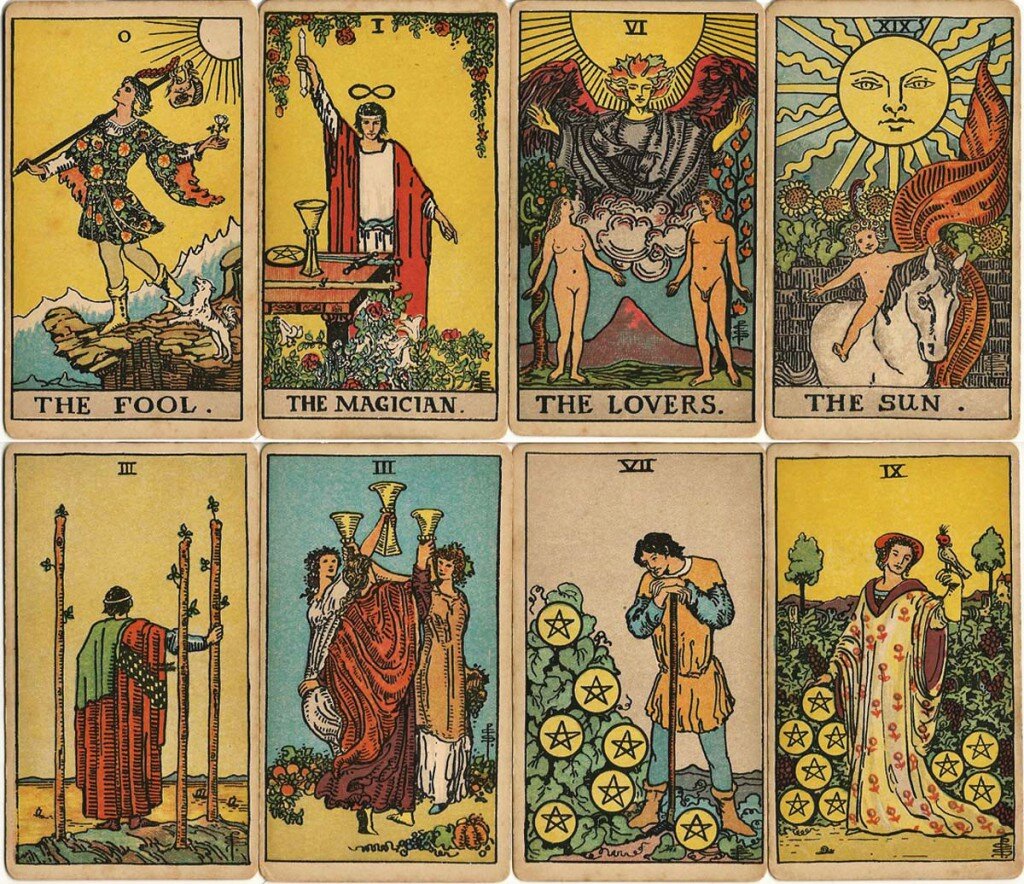Tarot & Oracle
The Tarot is at its tabletop practical basis a deck of decorated cards. Its order and appearance began to be somewhat uniform in the Renaissance, roughly the 15th Century. More complex meanings and purposes of this tool of gamesmanship seem to have begun early in the 18th Century, eventually growing and roaming into the wide spectrum of entertainment, interrogation, divination, and cartomancy that we know today.
A friend introduced me to the I Ching in college, and I quickly understood it to be an effective and enjoyable method of psychological investigation. After years of being put off by some of the more arcane and ambitious claims of tarot enthusiasts, I finally saw the analogy to the I Ching. After many years of resisting carrying the tarot in the store, I now stock it in the simple and inquiring spirit of my understanding. I am attracted to eye-catching art, of course, and I like the idea of cats being involved, of course, although I suspect cats may be more interested in pushing the cards off the table than in being supportive familiars. I respect the tarot’s history, and I will seek out books that place in the context of its origin and survival.
I am aware that the supply and diversity of decks is enormous, but I begin simply and humbly, alert to what my customers like.
Kitchen Table Tarot: Pull Up a Chair, Shuffle the Cards, and Let's Talk Tarot
Kitchen Table Tarot: Pull Up a Chair, Shuffle the Cards, and Let's Talk Tarot
PULL UP A CHAIR, SHUFFLE THE CARDS, AND LET'S TALK TAROT
Learn to read with your own voice and get the answers to all of your questions.
For years, Melissa Cynova has been sitting down with friends and neighbors who are curious about the tarot. She's heard all the questions and misconceptions that can confuse newcomers (and sometimes more experienced readers, too). Kitchen Table Tarot was written as a guide for anyone looking for no-nonsense lessons with a warm, friendly, and knowledgeable teacher.
Join Melissa as she shares straightforward guidance on decks, spreads, card meanings, and symbols. Filled with real-life examples and personal explanations of what it's like to read the cards, this book tells it like it is and provides the information you need to read with confidence.
Praise:
"If you're looking for an intuitive overview of how tarot might work for you and a pragmatic guide to learning the cards' core meanings, this book is the one. It's a warm, fast read with plenty of swearing, and I wish it could be bundled with every one of my tarot decks...It's that good. Buy one for you and one for your best friend, and go through it together. A+"—Maggie Stiefvater, #1 New York Times bestselling author and creator of The Raven's Prophecy Tarot
"Cynova's debut book struts forward to lead the pack with its authentic voice, candid and nimble teaching approach, and ability to pare down the principles and experience of reading tarot to its essentials...Exemplary. Eminent. Authoritative. A veritable gem." —Benebell Wen, author of Holistic Tarot
"A punch-in-the-gut teaching guide to the tarot...illustrating how much the tarot encourages each of us to find our own unique language and meanings when we begin this journey."—Terry Iacuzzo, author of Small Mediums at Large
"Melissa Cynova has written one of the most accessible, relatable tarot books ever. Pull up a chair, pop a cold one, and get ready for some straight-talking tarot lessons that will have you slinging the cards like a tarot badass in no time at all!"—Theresa Reed, author of The Tarot Coloring Book
"I've read many books about tarot readings, but this one is my favorite book so far."—Library Noire
"This book is a major asset to anyone curious about tarot...Reading Kitchen Table Tarot genuinely feels like sitting down with her and getting a whole workshop series delivered one-on-one."—Amber Unmasked
"Kitchen Table Tarot is for the beginner who wants to dip their toes in the tarot world for fun and personal study."—Spiral Nature
Winner of a 2018 IPPY Award for Best First Book

